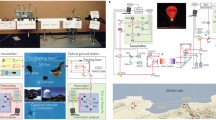Abstract
Quantum attacks that provide an undetectable eavesdropping of the ping-pong protocol operating over lossy quantum channels have already been demonstrated by Wójcik (Phys Rev Lett 90(15):157901, 2003) and Zhang et al. (Phys Lett A 333(12):46–50, 2004). These attacks provide a maximum information gain of 0.311 bits per protocol cycle as long as the induced loss rate remains acceptable. Otherwise, the skipping of some protocol cycles is advised to stay within an accepted loss limit. Such policy leads to a reduction in information gain proportional to the number of skipped cycles. The attack transformation parametrized by the induced loss ratio is proposed. It provides smaller reduction in information gain when the losses accepted by the communicating parties are too low to mount the most effective attack. Other properties of the attack remain the same.







Similar content being viewed by others
References
Boström, K., Felbinger, T.: Deterministic secure direct communication using entanglement. Phys. Rev. Lett. 89(18), 187902 (2002). doi:10.1103/PhysRevLett.89.187902
Boström, K., Felbinger, T.: On the security of the ping-pong protocol. Phys. Lett. A 372(22), 3953–3956 (2008). doi:10.1016/j.physleta.2008.03.048
Holevo, A.S.: Bounds for the quantity of information transmitted by a quantum communication channel. Probl. Inf. Transm. 9(3), 177–183 (1973)
Jahanshahi, S., Bahrampour, A., Zandi, M.H.: Security enhanced direct quantum communication with higher bit-rate. Int. J. Quantum Inf. 11(2), 1350020 (2013). doi:10.1142/S0219749913500202
Ostermeyer, M., Walenta, N.: On the implementation of a deterministic secure coding protocol using polarization entangled photons. Opt. Commun. 281(17), 4540–4544 (2008). doi:10.1016/j.optcom.2008.04.068
Pavičić, M.: In quantum direct communication an undetectable eavesdropper can always tell \(\psi {}\) from \(\phi {}\) Bell states in the message mode. Phys. Rev. A 87, 042326 (2013). doi:10.1103/PhysRevA.87.042326
Vasiliu, E.V.: Non-coherent attack on the ping-pong protocol with completely entangled pairs of qutrits. Quantum Inf. Process. 10, 189–202 (2011). doi:10.1007/s11128-010-0188-8
Wójcik, A.: Eavesdropping on the ping-pong quantum communication protocol. Phys. Rev. Lett. 90(15), 157901 (2003). doi:10.1103/PhysRevLett.90.157901
Zawadzki, P.: Security of ping-pong protocol based on pairs of completely entangled qudits. Quantum Inf. Process. 11(6), 1419–1430 (2012). doi:10.1007/s11128-011-0307-1
Zawadzki, P., Puchała, Z., Miszczak, J.: Increasing the security of the ping-pong protocol by using many mutually unbiased bases. Quantum Inf. Process. 12(1), 569–575 (2013). doi:10.1007/s11128-012-0403-x
Zhang, Z., Man, Z., Li, Y.: Improving Wójcik’s eavesdropping attack on the ping pong protocol. Phys. Lett. A 333(12), 46–50 (2004). doi:10.1016/j.physleta.2004.10.025
Acknowledgments
Author would like to acknowledge the support by the Polish National Science Center under the research Project UMO-2011/03/D/ST6/00413.
Author information
Authors and Affiliations
Corresponding author
Rights and permissions
About this article
Cite this article
Zawadzki, P. Eavesdropping on quantum secure direct communication in quantum channels with arbitrarily low loss rate. Quantum Inf Process 15, 1731–1741 (2016). https://doi.org/10.1007/s11128-015-1232-5
Received:
Accepted:
Published:
Issue Date:
DOI: https://doi.org/10.1007/s11128-015-1232-5




